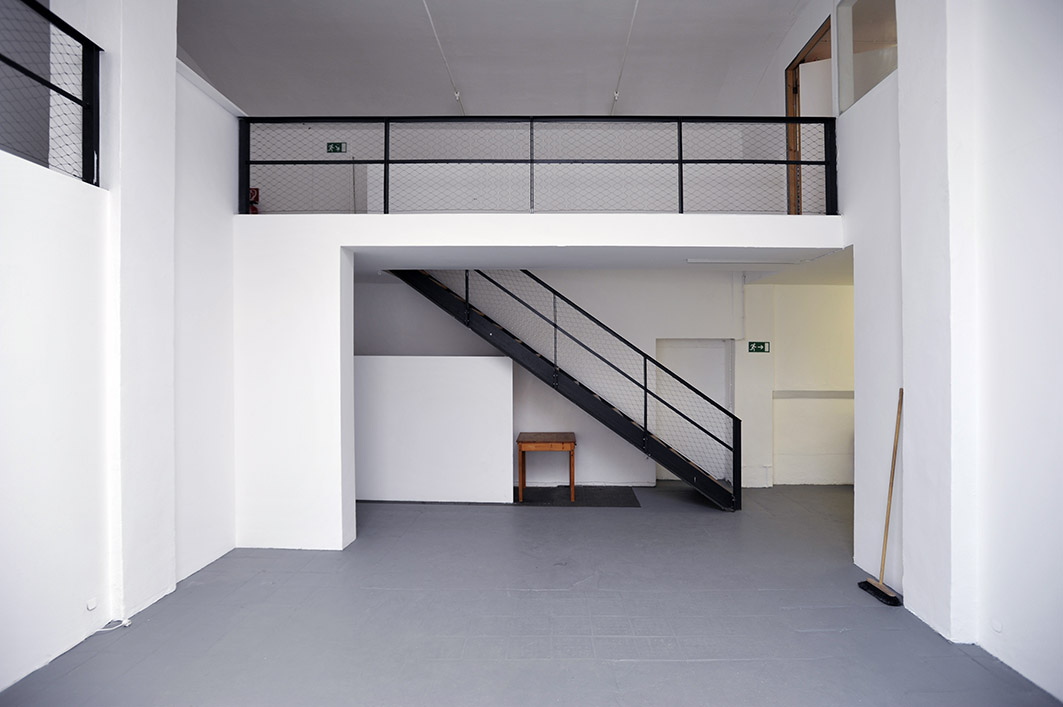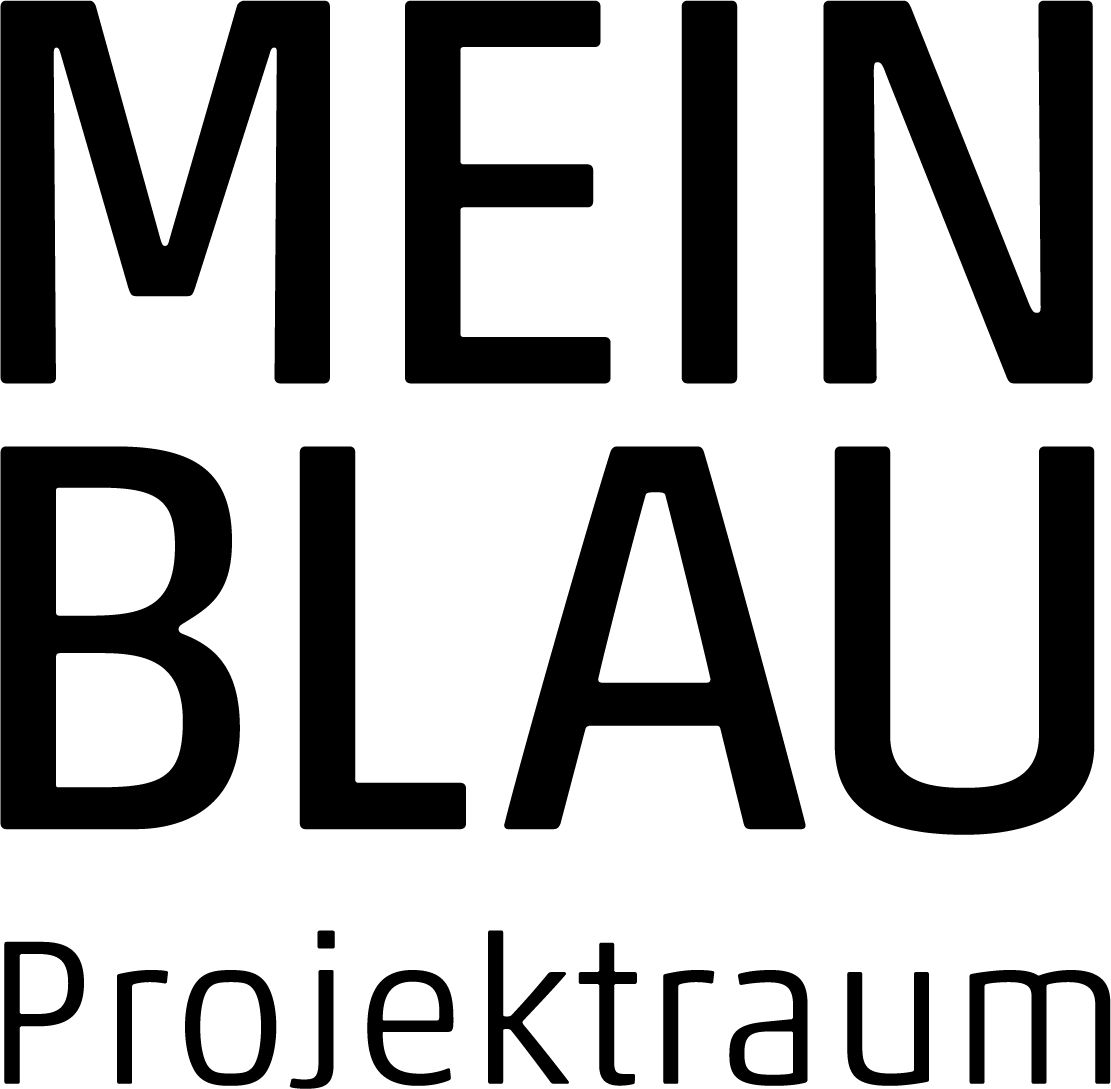
ABOUT
Meinblau Projektraum
The MEINBLAU project space was founded in 1997 by the members of Meinblau e.V. as the centrepiece of the art and studio building on Pfefferberg in Prenzlauer Berg Berlin. In 2003-2005, the artists working on site modernised the building under the planning and guidance of orange-architekten with funding from the EU.
As an exhibition venue for discursive, interdisciplinary visual art of aesthetic and social relevance, the project space serves as a forum for artistic self-organisation, intercultural networking of independent artists and cultural practitioners and their presence in the urban public sphere.

Exhibition programme
The programme of the Meinblau project space is designed and realised by the members of Meinblau e.V.. The projects we conceive or invite are centred around thematic group exhibitions of visual art that reflect contemporary social and political issues. Solo exhibitions are created explicitly for our project space. Lectures, symposia, artist talks, curatorial tours, discussions and teaching events offer in-depth insights into the concepts. We work regionally, nationally and internationally with cultural institutions as well as with artists from the independent scene. We regularly co-operate with independent Berlin project spaces and initiatives. Our permanent partners are the sound art initiative singuhr-projekte and the Asia Contemporary Art Platform NON Berlin.
Focus on intercultural exchange
Our curatorial projects aim to visualise the cultural diversity of the positions of artists living in Berlin and to initiate their international exchange. Since 2015, a major focus of our intercultural communication has been on joint projects with East Asian countries, explicitly the two nations of the Korean peninsula. In this context, 8 projects have already been realised.
Architecture of the Meinblau project space
The centrepiece of the Kunst- und Atelierhaus Meinblau is the 120m2 project space with its funnel-shaped skylight, which can be viewed from the gallery. The round vault with walls up to 6 metres high requires a spatial-installative dialogue between the exhibited art and the architectural situation. Consequently, when selecting our projects, particular emphasis is placed on the correspondence of the presentation with the spatial structure.

HISTORICAL SITE
The Pfefferberg in the nineties
In the cultural-historical interim period of post-reunification Berlin, the Pfefferberg buildings were used by a fluctuating, colourful mixture of different cultural producers, service providers and tradespeople.
The clubs and the romantic, morbid beer garden with adjoining hall on Schönhauser Allee were popular and played a decisive role in the city’s youth culture history in the 1990s. The summer open-air concerts and performances here explicitly promoted the collective feeling for the new eastern part of the city, which was characterised by a sense of new beginnings and apocalyptic associations in equal measure.
The Pfefferwerk Verein zur Förderung von Stadtkultur e.V. was in charge of this area. It organised around 200 cultural events per year and attracted thousands of visitors. Initially, the concert activities focussed on world music. Over time, the curators increasingly focussed on Francophone sound projects. Artists from the Maghreb and Black Africa were also present on the stages of the Pfefferberg. Eastern European and Latin American groups were also popular. The annual flamenco festival achieved cult status. In addition to the purely concert performances, the “Dance Days” were another successful large-scale project.
Electronic music experienced its creative heyday in Berlin in the early nineties. The Pfefferberg clubs became laboratories for the new movement. DJs collaborated with visual artists to fuse sounds with projections and light designs to create spatial installations. In the warmer months of the year, the projects sometimes moved upstairs from the basement and transformed the beer garden into a futuristic environment.
The area adjacent to Christinenstraße behind the venues initially remained largely unknown to the general public, but the few visitors hungry to discover it were always impressed by its post-industrial, ruinous splendour.
History could be read directly from the buildings. Half-bombed houses were rebuilt with rubble stones.
Further open spaces opened up at this location, which were utilised over time by a heterogeneous, diverse tenant community. From 1996, the Pfefferbergareal on Christinenstraße was home to the offices of Pfefferwerk Stadtkultur gGmbH, which has since been heavily involved in work with children and young people, promoting dialogue between the generations, designing activities for migrants, running workshops and carrying out labour market and employment projects. Other non-profit organisations and initiatives were also active there, such as mob e.V., WeTeK e.V., Förderband e.V. and the Intercultural Network, which expanded the socio-cultural spectrum with a variety of offers.
In addition to the companies in the Pfefferwerk group, artists’ studios, stone carving workshops, an architect’s office, small craft businesses, a Dutch beer wholesaler and a few temporary party organisers were set up, the legality of which could still be debated posthumously. Synergy effects quickly developed between the tenants at the time, similar to those that are still present in the newly developed Pfefferberg. Many companies and initiatives that were in their infancy at the time have since developed into renowned companies. Alexander Mende’s Pinguin Druck GmbH and orange architekten, who have also developed a post-industrial building in Marienburger Strasse, as well as the stone sculptors Hamann and Lucker, who have restored large parts of the Museum Island with their Oberbaum GmbH, may serve as examples.
The work on and in the individually used rooms of the Pfefferberg took place in the awareness of an immediate time limit, as no permanent rental contracts could be negotiated due to the situation.
Nevertheless, the weathered building fabric naturally required craftsmanship.
Improvisation was the order of the day. Doors had to be installed, electricity and water pipes laid. In winter, archaic stoves crackled.
In 1998, the Peter Weiss Foundation for Art and Politics staged “The Long Night of Thomas Bernhard” on the Pfefferberg as part of its event series “thomas bernhard. eine einschärfung” with artists from the local MEINBLAU e.V. organisation. In the centre of the Südhof, a twenty-metre-long “Thomas Bernhard coffin” was constructed from squared timber and covered with rusty sheet metal. There were barely recognisable flaps in the surface of the installation, under which the actors hid in the run-up to the first performance.
After the opening monologue by actor and director Martin Engler, several daring figures suddenly emerged from the underground. The performance of the early Thomas Bernhard drama “A Feast for Boris” thus got off to a spectacular start. Readings and dramatised text collages were presented in the adjoining buildings. Almost all users were involved in the project in one way or another by providing space and logistical support.
Founded in 1997, MEINBLAU e.V. still has an art and studio centre on the Pfefferberg. In the 1990s, in addition to discursive exhibitions, it primarily realised interdisciplinary art projects, combining visual art, theatre, literature and music to create non-conformist performance acts. In 1999, he began his international activities and organised the Berlin section at the Genoa Art Biennale “Arti Visive 3”.
In the present day, the content-related origins of the area – embedded in the aesthetic appearance of the new Pfefferberg – find their logical and professional counterpart. A place has been created that combines social projects with young and established culture.
Bernhard Draz in November 2009
NEWSLETTER
By clicking on the SUBSCRIBE button, you consent to the processing of your data in accordance with our privacy policy.
MEINBLAU e. V.
Christinenstrasse 18-19
Pfefferberg Haus 5
10119 Berlin
GERMANY
PARTNER
